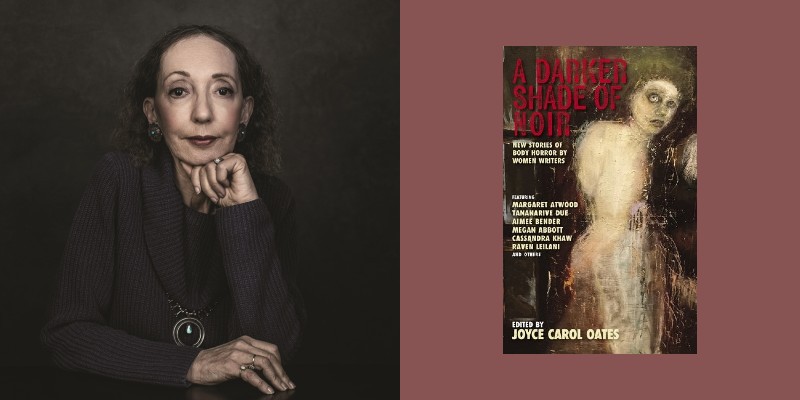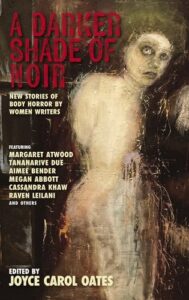Of mythological figures of antiquity, none are more monstrous than harpies, furies, gorgons—Scylla and Charybdis, Lamia, Chimera, Sphinx—nightmare creatures representing, to the affronted male gaze, the perversion of “femininity”: the female who in her physical being repulses sexual desire, rather than arousing it; the female who has repudiated the traditional role of submission, subordination, maternal nurturing. Since these fantasy figures have been created by men, we can assume that the female monster is a crude projection of male fears; she is the embodiment of female power uncontrolled by the male, who has most perversely taken on some of the qualities of the male hero—physical prowess, bellicosity and cunning, an appetite for vengeance and cruelty. As in the most lurid male fantasies of sadism and masochism, the female monster threatens castration and something even more primeval: humiliation.
Consider Medusa, the quintessential emblem of female body horror. We all know who Medusa was, yes?—a demonic female figure, a gorgon, with writhing venomous serpents springing from her head, and a face of surpassing ugliness; a bestial creature so horrific to behold that anyone who gazed upon her turned to stone. Since Medusa was also a mortal woman, the “hero” Perseus succeeded in beheading her, by observing her not directly but through a shield; as a favorite of the goddess Athena, Perseus then used Medusa’s severed head as a weapon of his own, turning enemies to stone.
Less generally known is that, in some variants of this legend, Medusa was originally an exceptionally beautiful young woman, with particularly beautiful hair; like many other mortal women in classical mythology, Medusa was raped by a god, in this case Neptune, king of the sea; because the rape occurred in the temple of Athena, the goddess was outraged, and with the cruel illogic of the patriarchy—Athena, born out of the head of Zeus, with no mother, was a male cohort—she punished the rape victim, not the rapist, transforming the beautiful Medusa into the horrific gorgon, with snakes springing from her head, and a very ugly face.
A cautionary tale: women should be beautiful and desirable even as they will be punished for being beautiful and desirable, at least outside the protective perimeters of marriage.
Should we know nothing of the female monsters of antiquity, still we would know that body horror in its myriad manifestations speaks most powerfully to women and girls. To be female is to inhabit a body that is by nature vulnerable to forcible invasion, susceptible to impregnation and repeated pregnancies, condemned to suffer childbirth, often in the past early deaths in childbirth and in the aftermath of childbirth. Fairy tales abound in stepmothers precisely because so many young wives died in childbirth that men naturally remarried as many times as their resources allowed. Even in civilized Western nations, to be female has been to be a kind of chattel, in lifetime thrall to the patriarchy; women could not own property, divorce, vote, take out mortgages, even acquire credit cards until relatively recently. Throughout history the female body has been condemned as the occasion for sin, for arousing sexual desire in the male. Strict dress codes for women are a characteristic of patriarchal religions in which female physicality is considered repugnant, while male physicality—virility—is revered. The punishment of Medusa is in line with age-old punishments for women and girls who have the bad luck to attract unwanted sexual attention from men; but to spurn such a role, refusing to marry, to procreate, to acquiesce to the model of meek, subservient femininity, symbolized, for instance, by the Virgin Mary, has been to risk being declared unnatural—“bitch,” “witch.” The ultimate punishment of the female who resists femininity was to be burned at the stake, condemned to death by religious patriarchs for the good of the commonweal.
In Mary Shelley’s Frankenstein; or, The Modern Prometheus (1818), a fever dream of an epistolary novel, the most powerful passages spring from dreamlike, surreal sources of anxiety: the creature assembled by Dr. Frankenstein is the very embodiment of a freakish birth, oversized, with ill-matching parts taken from a graveyard and a yellowish, parchment-like skin. We know that Mary Shelley was only eighteen at the time she began composing Frankenstein; she was unmarried and pregnant, living with the Romantic poet Percy Shelley with whom she had eloped to Italy, in unstable circumstances; Percy Shelley had left behind a teenaged wife in England, the mother of his child, who would soon commit suicide. Amid such turmoil and uncertainty, Mary Shelley created one of the most horrific of literary monsters, as if fantasizing the worst possibilities of the impending birth; it’s likely too that Mary Shelley identified with the creature, in his feelings of isolation and exile. (As it happened, the baby Mary Shelley was carrying during the composition of Frankenstein would die at birth; she would have three other babies who also died, and only one who survived. Until the sudden death of Percy Shelley, Mary Shelley was almost continuously pregnant or nursing for eight years.)
In recent decades, body horror has been established as a literary subgenre of horror and dark fantasy. Monsters and freaks of all kinds have always abounded in popular fiction and movies, and in such cult classics as Tod Browning’s Freaks (1932)—a graphic film more disturbing in our time than it was decades ago when the casting of grotesquely disabled people as “freaks” was not viewed as morally repugnant. A director generally recognized as a master of high-quality body horror is David Cronenberg, whose films (The Brood, Dead Ringers, Crash, Crimes of the Future) contain visceral, visual shocks that function as both literal and psychological horror. (The sight of the naked body of the estranged wife and mother in The Brood, whose hatred of her ex-husband has hideously deformed her body, is one of the most memorable.) Nor is anyone who has read Katherine Dunn’s Geek Love likely to forget the carnival family whose grotesque brood has been deliberately created by the parents with the aid of amphetamines, arsenic, and radioscopes—a Dickensian tale in which the surreal and the “real” collide in an exploration of a capitalist-consumer society from the perspective of self-defined “freaks” who are not ashamed but proud of their lineage.
*
The body horror of A Darker Shade of Noir is as varied and unpredictable as the writers exploring the genre, and as unclassifiable as the hauntingly sinister illustrations by Laurel Hausler that accompany them. Though the protagonists of the stories may wreak havoc upon others or are victims themselves of bodily horror, it is only in Cassandra Khaw’s lyrically realized evocation of lycanthropy, “Muzzle,” that a female protagonist is a monster—“My own wolf, the one that had slept encysted in my lizard brain.” In Aimee Bender’s bizarrely conversational “Frank Jones,” a young female office worker creates her own miniature Frankenstein out of peculiar growths emerging from her body, which she employs to keep her coworkers at a respectful distance; she has been accused of “loneliness” and “weirdness” in the workplace, and this is her self-defense.
Megan Abbott (“Scarlet Ribbons”), whose prose fiction typically moves with the disconcerting swiftness of a suspense film, depicts the terrifying night world that lurks beneath the day world of an ordinary suburban neighborhood in which a grisly family murder has occurred, as it is experienced by a young girl mesmerized by tales she has heard of a loving father bludgeoning his family to death—a loving father not unlike her own. In Joanna Margaret’s suspenseful “Malena” a female sculptor must contend with the monstrous being—a “parasitic twin”— emerging from within her own body, while in Tananarive Due’s “Dancing,” a selfless forty-year-old woman who has devoted half her life to caring for her infirm grandmother succumbs to a fit of dancing and demonic laughter after her grandmother’s death—her body “at war with itself.” The spirit of her grandmother, denied a career in ballet because of her race, becomes a curse, frenetically dancing through her.
The curse of the body at war with itself in a woman who is both a creative artist and Black amid an insidiously racist society is explored with unnerving intensity by Raven Leilani in her harrowing “Breathing Exercise,” which is likely to leave the reader breathless by its end. Lisa Lim’s graphic tale “Dancing with Mirrors” is a terrifying grandmother-mother-daughter parable of how a “toxic tongue” can indeed be a curse on subsequent generations of women; how body dysmorphia may be inherited, not genetically but through the tales we tell about ourselves.
Amid this gathering of highly imaginative stories, Margaret Atwood’s “Metempsychosis, or The Journey of the Soul” is very possibly the strangest; but then Atwood, one of the most inventive and original prose writers of our time, is never predictable. In this fabulist tale of a most unusual metempsychosis, a creature of another species finds itself peacefully “space-sharing” with a human woman, a midlevel customer service representative at a bank, with unexpected results for both. In Lisa Tuttle’s savagely satirical “Concealed Carry”—set, appropriately, in the most rabid of American gun states, Texas—a firearm acquires a malevolent life of its own, parasitically attaching itself to a human woman.
Aimee LaBrie’s “Gross Anatomy” is the only story in A Darker Shade of Noir with a male protagonist, a medical student whose behavior, with a female corpse in the school’s morgue, is indeed gross—but does not go unpunished. Yumi Dineen Shiroma’s “Her Heart May Fail Her” is a bold appropriation of Bram Stoker’s hapless female characters Lucy and Mina (Dracula), revisioning them in a sensuously evoked erotic triangle, one side of which is a female vampire; while Elizabeth Hand’s “The Seventh Bride, or Female Curiosity” appropriates the centuries-old tale of Bluebeard and his victim-wives, in this case as a traveling theatrical troupe in nineteenth-century England with a most unusual cast of characters both living and deceased.
Set as well in the nineteenth century, Valerie Martin’s “Nemesis” pits a vain, callow, narcissistic young man against a canny middle-aged wife and mother whose smallpox-disfigured face the young man finds repulsive, with fitting results for the vain man whose beauty is destroyed forever; while Sheila Kohler’s “Sydney” depicts the marriage of a naïve young girl and a duplicitous older man in a triangular relationship with a most unusual lover. (Since much of A Darker Shade of Noir is, indeed, dark, it seemed appropriate to both begin and end the collection with stories of victim-women who become, in the course of confronting their situations, ingeniously empowered.)
“The Chair of Tranquility” may be read as prose fiction or prose poetry, the lone contribution in A Darker Shade of Noir that involves neither the surreal nor the supernatural, but is based upon historical records: the interior monologue of a woman entrapped in a diabolical but widely respected nineteenth-century medical treatment for so-called hysteria. This treatment, known as the “rest cure,” advocated by the distinguished physician Silas Weir Mitchell (1829–1914), was in effect the enforced infantilization of women who may have been in (healthy) revolt against the confinement of their roles in society; any variance from the norm of obedient daughter/wife/mother was considered an aberration, indeed “hysteria,” of which they had to be cured no matter how extreme the price.
Through these very different stories, something like a pulse beats in defiant opposition to the confinement of the female by the patriarchy, as by images of self-laceration and defeat internalized by tradition. Whether the rebellion is overt or indirect, successful or fatally thwarted, we are moved deeply by the varying ways in which, in Tananarive Due’s words, a buried dream could be reborn like a curse.
Joyce Carol Oates
February 2023
___________________________________
Copyright 2023 Joyce Carol Oates, from the introduction to the anthology A Darker Shade of Noir: New Stories of Body Horror by Women Writers edited by Joyce Carol Oates, reprinted by permission from Akashic Books (akashicbooks.com).



















